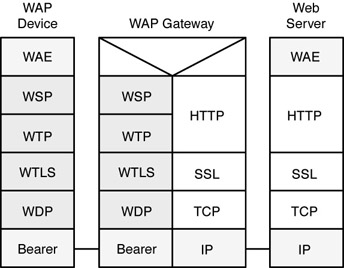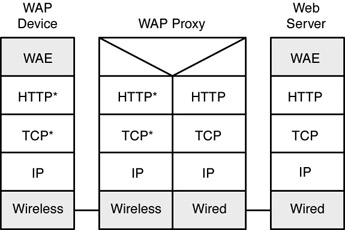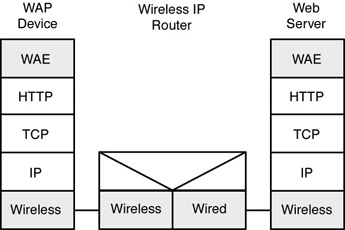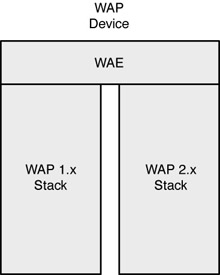Sample Configurations of WAP Technology
|
|
Sample Configurations of WAP Technology
Because several of the services in the WAP stack can be provided using different protocols based on the circumstances, there are more than one possible stack configurations. The following figures depict several possible protocol stacks using WAP technology. These are for illustrative, informative purposes only and do not constitute a statement of conformance or interoperability, nor is this set of examples exhaustive.
Figure 7-8 depicts the protocol stacks for the original WAP Architecture. The WAP Gateway converts the hypermedia transfer service between the datagram-based protocols (WSP, WTP, WTLS, WDP) and connection-oriented protocols commonly used on the Internet (HTTP, SSL, TCP).

Figure 7-8: An example of WAP 1.x gateway
Figure 7-9 depicts a WAP HTTP proxy. The proxy configuration is widely used in the Internet for ordinary web access, multimedia data, e.g. music, video clip downloading and so on. This configuration locates the WAP Proxy between wireline and wireless networks to enhance performance by using the wireless profile of TCP (as shown with TCP*). In addition to TCP optimizations, the wireless profile of HTTP (as illustrated by HTTP*) allows for further performance enhancements. Both profiles comprise well-defined IETF options that provide for efficient operation over wireless networks as within the scope of WAP. The wireless profiled versions are interoperable with TCP and HTTP.

Figure 7-9: An example of WAP HTTP proxy with profiled TCP and HTTP
Figure 7-10 is a WAP HTTP proxy that has established a connection-oriented tunnel to the web server (e.g., in response to a CONNECT command). This configuration is used to allow TLS to provide end-to-end security between mobile terminal and origin server. E-commerce is a compelling use case for end-to-end security.

Figure 7-10: An example of WAP proxy support for TLS tunneling
Figure 7-11 depicts a WAP device directly accessing a web server via the Internet. The wireless IP router is a standard part of an IP network that is used to transfer IP packets from one link layer (e.g., the wireless link) to another (e.g., the wired link). This configuration can apply to the case where bearer-level security (such as IPSec) is utilized. In the Direct Access scenario, wireless optimizations as defined by the Wireless Profiles for TCP and HTTP may not be available.

Figure 7-11: An example of direct access
While the previous configurations show single protocol stacks for each WAP configuration, Figure 7-12 depicts a device that supports both the 1.x and 2.x protocol stacks. This configuration is useful in cases where a device needs to interoperate with both old and new WAP servers.

Figure 7-12: Dual stack support
|
|
EAN: N/A
Pages: 88